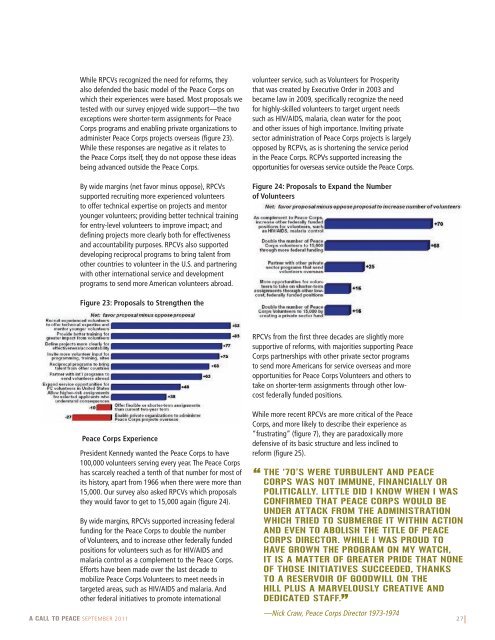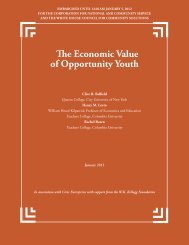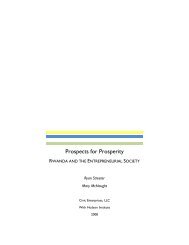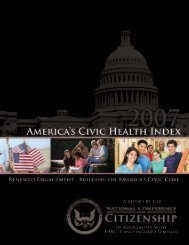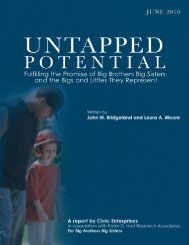A Call to Peace - Civic Enterprises
A Call to Peace - Civic Enterprises
A Call to Peace - Civic Enterprises
- No tags were found...
You also want an ePaper? Increase the reach of your titles
YUMPU automatically turns print PDFs into web optimized ePapers that Google loves.
While RPCVs recognized the need for reforms, theyalso defended the basic model of the <strong>Peace</strong> Corps onwhich their experiences were based. Most proposals wetested with our survey enjoyed wide support—the twoexceptions were shorter-term assignments for <strong>Peace</strong>Corps programs and enabling private organizations <strong>to</strong>administer <strong>Peace</strong> Corps projects overseas (figure 23).While these responses are negative as it relates <strong>to</strong>the <strong>Peace</strong> Corps itself, they do not oppose these ideasbeing advanced outside the <strong>Peace</strong> Corps.By wide margins (net favor minus oppose), RPCVssupported recruiting more experienced volunteers<strong>to</strong> offer technical expertise on projects and men<strong>to</strong>ryounger volunteers; providing better technical trainingfor entry-level volunteers <strong>to</strong> improve impact; anddefining projects more clearly both for effectivenessand accountability purposes. RPCVs also supporteddeveloping reciprocal programs <strong>to</strong> bring talent fromother countries <strong>to</strong> volunteer in the U.S. and partneringwith other international service and developmentprograms <strong>to</strong> send more American volunteers abroad.volunteer service, such as Volunteers for Prosperitythat was created by Executive Order in 2003 andbecame law in 2009, specifically recognize the needfor highly-skilled volunteers <strong>to</strong> target urgent needssuch as HIV/AIDS, malaria, clean water for the poor,and other issues of high importance. Inviting privatesec<strong>to</strong>r administration of <strong>Peace</strong> Corps projects is largelyopposed by RCPVs, as is shortening the service periodin the <strong>Peace</strong> Corps. RCPVs supported increasing theopportunities for overseas service outside the <strong>Peace</strong> Corps.Figure 24: Proposals <strong>to</strong> Expand the Numberof VolunteersFigure 23: Proposals <strong>to</strong> Strengthen theRPCVs from the first three decades are slightly moresupportive of reforms, with majorities supporting <strong>Peace</strong>Corps partnerships with other private sec<strong>to</strong>r programs<strong>to</strong> send more Americans for service overseas and moreopportunities for <strong>Peace</strong> Corps Volunteers and others <strong>to</strong>take on shorter-term assignments through other lowcostfederally funded positions.<strong>Peace</strong> Corps ExperiencePresident Kennedy wanted the <strong>Peace</strong> Corps <strong>to</strong> have100,000 volunteers serving every year. The <strong>Peace</strong> Corpshas scarcely reached a tenth of that number for most ofits his<strong>to</strong>ry, apart from 1966 when there were more than15,000. Our survey also asked RPCVs which proposalsthey would favor <strong>to</strong> get <strong>to</strong> 15,000 again (figure 24).By wide margins, RPCVs supported increasing federalfunding for the <strong>Peace</strong> Corps <strong>to</strong> double the numberof Volunteers, and <strong>to</strong> increase other federally fundedpositions for volunteers such as for HIV/AIDS andmalaria control as a complement <strong>to</strong> the <strong>Peace</strong> Corps.Efforts have been made over the last decade <strong>to</strong>mobilize <strong>Peace</strong> Corps Volunteers <strong>to</strong> meet needs intargeted areas, such as HIV/AIDS and malaria. Andother federal initiatives <strong>to</strong> promote internationalA CALL TO PEACE SEPTEMBER 2011While more recent RPCVs are more critical of the <strong>Peace</strong>Corps, and more likely <strong>to</strong> describe their experience as“frustrating” (figure 7), they are paradoxically moredefensive of its basic structure and less inclined <strong>to</strong>reform (figure 25).“T HE ‘70’S WERE TURBULENT AND PEACECORPS WAS NOT IMMUNE, FINANCIALLY ORPOLITICALLY. LITTLE DIDI KNOW WHEN I WASCONFIRMED THAT PEACE CORPS WOULD BEUNDER ATTACK FROM THE ADMINISTRATIONWHICH TRIED TO SUBMERGE IT WITHIN ACTIONAND EVEN TO ABOLISH THE TITLE OF PEACECORPS DIRECTOR. WHILE I WAS PROUD TOHAVE GROWN THE PROGRAM ON MY WATCH,IT IS A MATTER OF GREATER PRIDE THAT NONEOF THOSE INITIATIVES SUCCEEDED, THANKSTO A RESERVOIR OF GOODWILL ON THEHILL PLUS A MARVELOUSLY CREATIVE ANDDEDICATED STAFF.”—Nick Craw, <strong>Peace</strong> Corps Direc<strong>to</strong>r 1973-197427|


